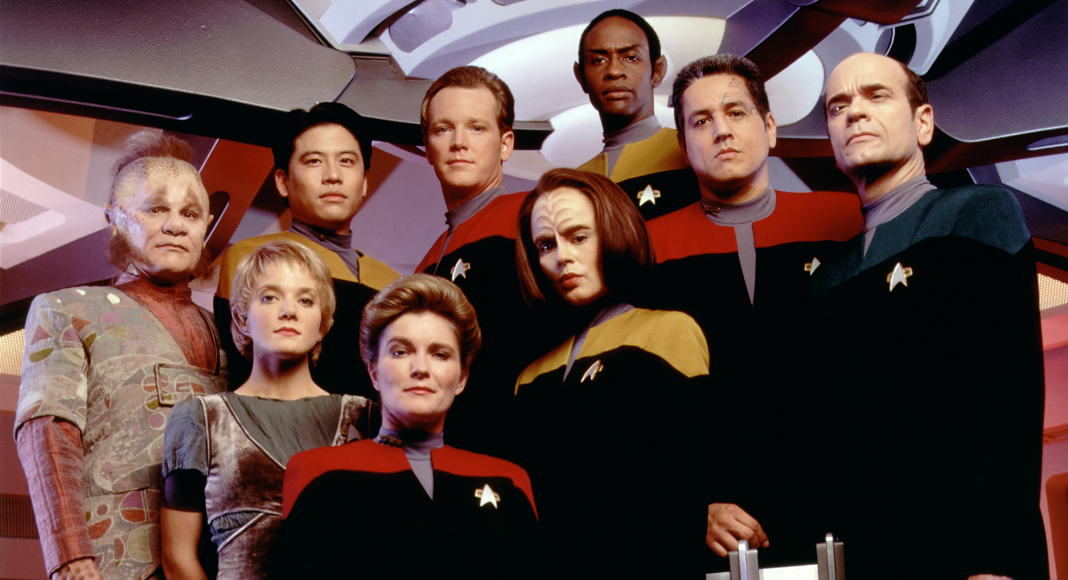Star Trek Voyager turned 25 last year! To celebrate this impressive milestone, we are going to take a retrospective look back at the groundbreaking series!
In what would have been Star Trek: Voyagers 25th Anniversary, the world was hit by a global pandemic that impacted on celebrations. While it’s important to stress that the health and safety of everyone is always paramount, its shame that planned events around the globe had to be cancelled. So, as today marks the anniversary of the shows pilot episode ‘Caretaker’ and although it may be a little later than planned, the team here at TrekCentral.net wanted to share with you our look back and celebration of one of the best entries of the Star Trek Franchise.
January 16th, 1995 is the date the Pilot episode, “Caretaker” first aired, launching the third Star Trek show alongside DS9 that was based in The Next Generation era; Star Trek Voyager. Voyager was the first series of Star Trek to use Computer Generated Imagery, as opposed to models. While the exterior shots were still miniatures, the opening titles, and various external shots, for example, the battle scenes throughout the show were CGI. By season 3, CGI became a mainstay for the series, utilised for shuttles, enemy ships and certain environments which had previously been shot on location.
Despite its ups and downs and consistently lower view ratings compared to The Next Generation, it still spanned 7 seasons from 1995-2001 with a total of 172 episodes, something that has since been no easy feat for Sci-Fi shows to replicate.
Fun fact: “Caretaker” remains the most expensive pilot episode in television history, having been filmed across 31 days at multiple locations and costing $23 million dollars.
First Female Captain
Star Trek Voyager introduced our first female lead Captain in Kathryn Janeway, portrayed by Kate Mulgrew, however initially the part was given to French-Canadian actress, Genevieve Bujold, back when the character was known as Nicole Janeway. Garrett Wang, who played Ensign Harry Kim for the entirety of the show’s run, shared in one of his podcasts “The Alpha Quadrant” that Genevieve had two young children at home, whom she was concerned she would not see grow up due to the busy schedule of shooting the show. She also shared with him that she wished to be Captain first, Woman second, which she felt wasn’t going to be the case. Nonetheless, she did not wish to commit and ultimately quit on her second day, confirmed by Garrett in the same podcast, after speculation of her being fired due to disagreements in her performance.
The creators at first decided to recast another male Captain and to keep the balance, they considered firing one the male support actors and recast with a female. Though multiple other actresses were considered for the role of Janeway, it was Kate Mulgrew who won out and the character structure remained the same.
The character of Janeway has become so popular within the Star Trek fanbase that recently fans successfully petitioned for Captain Janeway to have a statue in her honour in Bloomington, Indiana, to mark her future Birthplace. The statue was erected in October 2020 with Kate Mulgrew attending the ceremony via video link-up.
With Janeway becoming a role model for millions of women over the years, is something that Kate Mulgrew never anticipated. Speaking at the unveiling of her statue in Bloomington, Mulgrew said:
“No, it wasn’t [something I anticipated]. I think that innocence or naivete, or perhaps even that blindness has stood me in good stead when it came upon me. I think a lot of people who are lucky enough to be in leadership roles do not expect it to come. And certainly not in this way, as an actress. But it transcended acting very, very quickly. I realized that I was going to be acting as a model, particularly for young women, and even more particularly for young women in science. So being able to marry my creative passion with a legacy of this kind was wonderful and continues to be wonderful. So when I use words like how it’s a privilege, an honor, it is because there are not yet other words that can surpass them in meaning. It is a great privilege to be able to have played her and to know of her great, great resonance in the cultural world today”
Janeway has since gone on to appear in Star Trek: Nemesis as an Admiral and has been included in the series of Autobiographies published by Titan Books which also include Captain Kirk and Captain Picard as part of the collection. Kate Mulgrew will be soon reprising her role as Captain Janeway, albeit in animated form in Star Trek: Prodigy, which is currently in pre-production.
‘Caretaker’
The pilot episode aired in the USA on January 16th, 1995 during the first golden age of Star Trek on our TV screens and was the 5th series to set in the Star Trek universe. Initially planned to help Paramount Pictures launch a new TV network (sounds familiar) and to continue airing two Star Trek shows at the same time following the end of The Next Generation, the other being Deep Space Nine. Its where Deep Space Nine, the story of ‘Caretaker’ begins.
Docked at Deep Space Nine, Kathryn Janeway beamed aboard Starfleets’ latest Intrepid-class starship, the USS Voyager NCC-74656 complete with 15 decks, a maximum warp speed of 9.975, advanced bio-neural circuitry and the first starship to feature an Emergency Medical Hologram, but more on that in a few.
The senior crew consisted of 1st Officer Lt Cmdr Cavit, an unnamed chief medical officer, Helmswoman Lt Stadi, Operations Officer Harry Kim, and then there was Tom Paris, who was at first an observer and Maquis Consultant released from a Federation Penitentiary to aid in the capture of a Maquis ship that Voyagers Chief of Security and Tactical officer, Lt Tuvok was currently aboard as a spy.
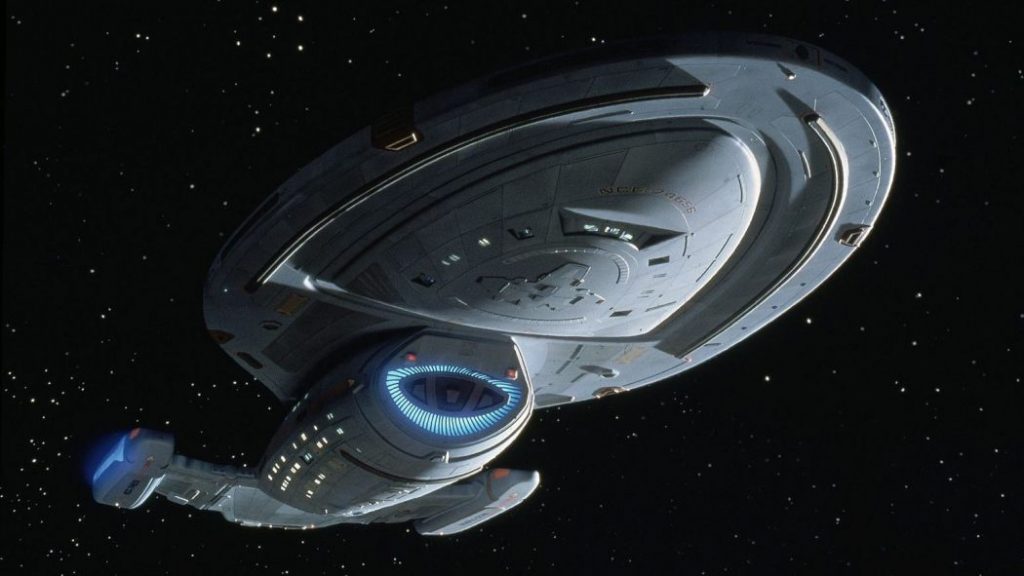
After leaving DS9 for the treacherous Badlands in pursuit of the Maquis ship, Voyager is hit by a displacement wave which throws the ship end for end, causing a hull breach and several internal malfunctions, including disrupted communications with engineering and sickbay. Shortly after they find Cavit and Stadi dead, they discover that they are no longer in the Badlands and are met by an enormous array firing a steady stream of pulses into the distance, then Harry announces to the bridge; they had travelled over 70,000 light years.
Enter the Delta Quadrant! The only corner of the Milky Way so far not explored in the Trek Universe. What better ship to have than the aptly named and appropriately outfitted state of the art science vessel, Voyager? Thus, setting up the whole premise of Star Trek: Voyager, the long journey back to Federation space while exploring a vast, uncharted part of the galaxy. Sending Voyager to the Delta quadrant allowed the writers to break away from anything established in the current crop of Star Trek shows. Allowing for new technologies, new threats, and more importantly new alien species for the crew to contend with. The Delta quadrant could well have been the old Wild West of the USA with lawless factions and quarrelling, territorial aliens, it could have been very easy for the crew to abandon the code of the Federation. But in the face of all this adversity the morals and ethics of the Federation that had been embedded in Captain Janeway never faulted. A true life lesson that you must hold on to your ideals and what you believe in when facing uncertainty.
Included in the fatalities are the limited medical staff including the ships doctor, which would naturally at first be seen as a cause for concern amongst fans. “Why does Voyager have a total lack of Science and Medical staff, considering it’s a Science vessel?” An argument could be made that Voyager was only sent out to recover a single ship, but then wound up with more than they bargained for… or maybe they just didn’t arrive until Tuesday?
“Please state the nature of the medical emergency”
In any case, the position is filled by the Emergency Medical Hologram (EMH) known simply as The Doctor, who at first is expecting to only stand in for a short period but becomes the mainstay of sickbay following the death of the CMO. Across the series, The Doctor was allowed to make advances to his program; always looking to improve on his core design and develop more human characteristics was something that mirrored the ambitions of another Star Trek character, namely Data from TNG. Over the years the Doctor expands his own programming to include hobbies and interests, friendships, compassion, and love all the while earning the respects of his crew members. He even makes his own perfect family to visit on the holodeck, which after a little tinkering from Lt. B’Elanna Torres, has a not so happy ending.
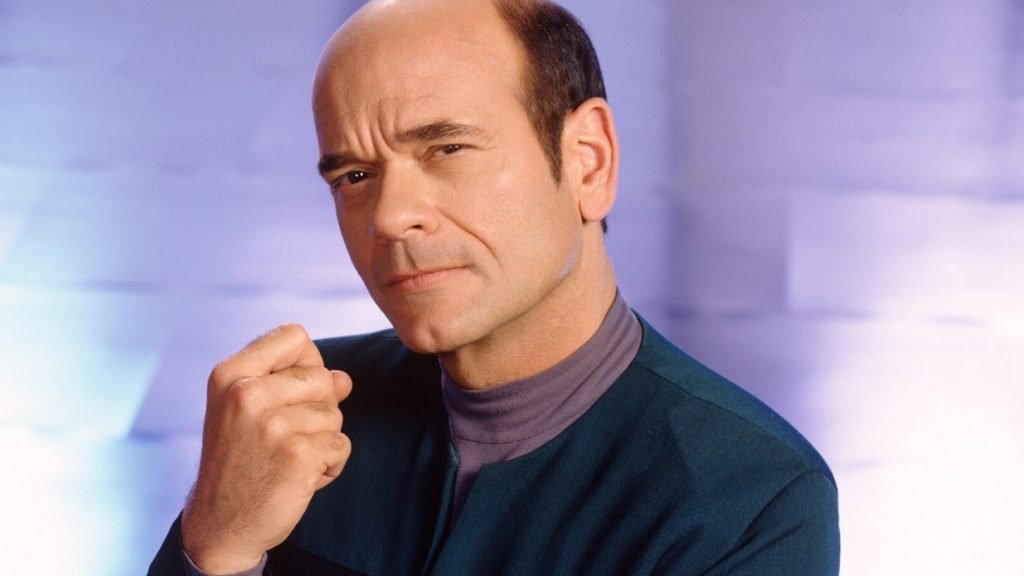
The Doctor also writes a holo-novel, “Photons Be Free” which gets him in trouble with Starfleet. The novel depicts Voyager – or in his story USS Vortex – as crew who were oppressive against him as a hologrammatically being. Starfleet calls for him to rescind the novel from his publisher, which at first was denied, so he and the crew to fight for his rights as a person, not a piece of owned technology, again echoing sentiments shown by Lt. Commander Data in TNG. A recurring theme across the seven seasons of Star Trek: Voyager was the ethical question of the Doctor being a sentient being and therefore being treated as such by the crew as oppose to just a piece of technology at the crew’s disposal. Nothing but a tool. As the seasons progressed a bond was formed and indeed the Doctor became an important part of the social aspects of Voyagers daily life. Nothing optimised his importance than the ECH addition to his programming.
In absolute dire situations, should the senior crew have been incapacitated and the Chain of Command broken down, the EMH had another mode: Emergency Command Hologram (ECH). Initial conceived by the Doctor following the installation of a daydreaming sub-routine which he created as part of his ongoing development. He submitted this addition to his skill set to Captain Janeway which was initially refused but after seeing the ECH in practice, Janeway reconsidered her position. The ECH was only called into action once outside of his malfunctioning daydreams when the crew are kidnapped and recruited on to a “Workforce” and he was left in command. The next time we see the ECH, The Doctor is being blackmailed and forcibly took command of Voyager to steal the Warp core to rescue Janeway in the episode “Renaissance Man”.
The Doctor’s holographic program was restricted to sickbay in early seasons, but this all changed in the two-part story arc of “Futures End” in which he procures a piece of 29th century technology from Captain Braxton, the mobile emitter. Thanks to this nifty device he is able to move freely about the ship, instead of being confined to Sickbay and the Holodecks.
The technology of the mobile emitter free’s The Doctor from the shackles of sickbay, allowing him to become a more valued member of the crew. The ability to accompany senior staff on away missions, take part in delegations all helped towards The Doctors character development, played with amazing range by Robert Picardo. The impact the Doctor has on Star Trek: Voyager can’t be understated. He was instrumental in contacting Starfleet following the discovery of a vast communications network by 7 of 9, which spanned a large portion of both Delta and Alpha Quadrants. He was sent through the network to ship on the other end which turned out to be the highly classified and experimental USS Prometheus. The Doctor speaks directly with Starfleet Command; after learning that Voyager had been declared officially lost 14 months earlier he makes sure that the error in Starfleets records are corrected. This is all after rescuing the USS Prometheus – with the help from a very amusing turn from comedian Andy Dick as the EMH Mark II – from occupying Romulans hell bent on using the ship as a weapon.
It’s safe to say that over Voyagers 7-year trip through the Delta quadrant, The Doctor develops most as a character. With all each new ‘Human’ experience becoming the building blocks to his characters personality. Eventually trying to pass on what he had learned to help 7 of 9 integrate herself back into Human life following her liberation from the Borg.
The Maquis Crew
The Maquis were a rebellious organisation of Federation colonists who banded together to fight against the Cardassian occupation of their homes in the demilitarized zone. Considered terrorists by the Cardassians and as traitors by the Federation. In Voyagers pilot, Janeway and her crew race towards a Maquis ship in order to apprehend them before being destroyed by Cardassian vessel. The ship makes its way into the Badlands with Voyager in hot pursuit. Following the 70,000 light-year trip to the Delta quadrant, Janeway soon learns that the Maquis ship was not destroyed in the Badlands, but also thrown into the far reaches of the galaxy ahead of Voyager.
The Maqui had featured in a variety of episodes but mostly explored in better detail during Deep Space Nine. Although their intentions were noble, the freeing of their people from Cardassian occupation, it was a bold move to have them as crew members within the ranks of Voyagers command structure as they were very much ‘in-universe’, an enemy of the Federation. The advantage of this is that it could have opened a plethora of storytelling opportunities that would allow for unrest and discontentment amongst the two sets of crews.
It’s maybe unfortunate then that this opportunity was not capitalised on more by the writers. One of the several things many fans question about Voyager, is that by the events of “Parallax” (Episode 3 of season 1), the two crews had already seemingly meshed together, given provisional ranks to fill the slots left behind due to the untimely passing of the previous senior crew, and we’re okay with that, right? It’s true that the two sets of crew members seem to assimilate fairly easy with nothing more than a few heated arguments and pointed fingers across the first season. The only real threat coming from Seska when her true identity is revealed in episode 11, ‘State of Flux’.
Ultimately, we were gifted with not only a unique set up in our main command crew structure but also some of the most memorable and diverse additions to Star Trek lore.
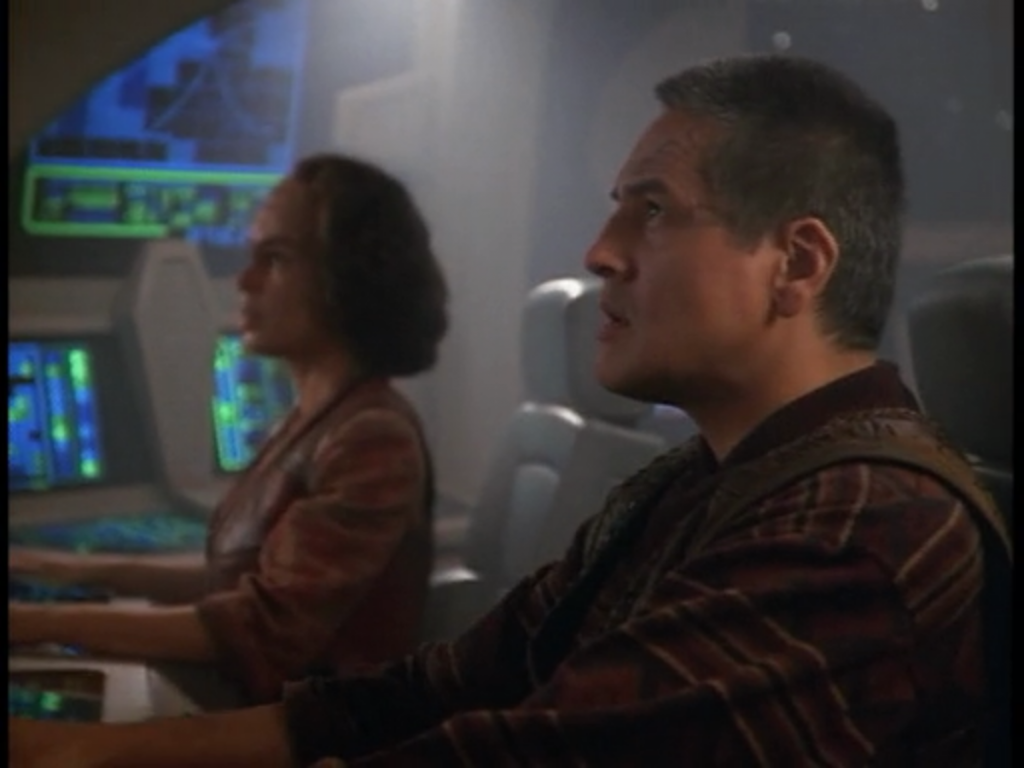
Commander Chakotay assumed the position of provisional first officer, a former Starfleet officer and a leader the Maqui crew, it was understandable that he was given a position of authority in order to help facilitate a smooth transition for the two crews to merge with as little resistance as possible. The character was praised as “ground-breaking” for Native-American in the sci-fi genre. Throughout Voyagers run there was always a hint of a possible relationship between Chakotay and Janeway which never fully transpired, so it was surprising to see that near the end of season 7 he became romantically involved with 7 of 9.
B’Elanna Torres is the half Human-Klingon with an attitude problem and anger management issues. Initially up against Lt Joe Carey for the role of Chief Engineer, she wound up winning when she demonstrated her skills to free Voyager from a quantum singularity. B’Elanna dropped out of the Academy before graduation due to problems with authority, something that rears its head many times in the early years of Star Trek: Voyager, later joining the Maquis.
Tom Paris was given a field commission of Lieutenant and chief conn officer as he previously argued about being the best pilot they have when initially being recruited as an observer. Tom was dishonourable discharged from Starfleet and joined the Maquis, but he was captured during his first mission and was placed in a penitentiary.
Fun Fact: Robert Duncan McNeill previously starred as Cadet Nicholas Locarno in The Next Generation, as leader of the Academy Honour Squadron, an Elite Flying Squad, of which Wesley Crusher was a part of. He had the team perform a highly dangerous and banned maneuver, resulting in the death of a fellow cadet and he was expelled. It was intended that the character remain the same and his crimes stand for his reintroduction for the Voyager series. However the part was altered slightly. Tom was still part of the Honour Squad, but later crashed a shuttle and falsified records when 3 fellow officers were killed, he later confessed and he was discharged- You can see the similarities. However it is not confirmed if they are still supposed to be the same character.
Enter Seven of Nine, Tertiary Adjunct of Unimatrix 01
All contracts with the exception of Kate Mulgrew were to be renegotiated at the end of Season 3, which was going to have a cliff-hanger ending, used to kill off a character and to give the series new blood, as it were.
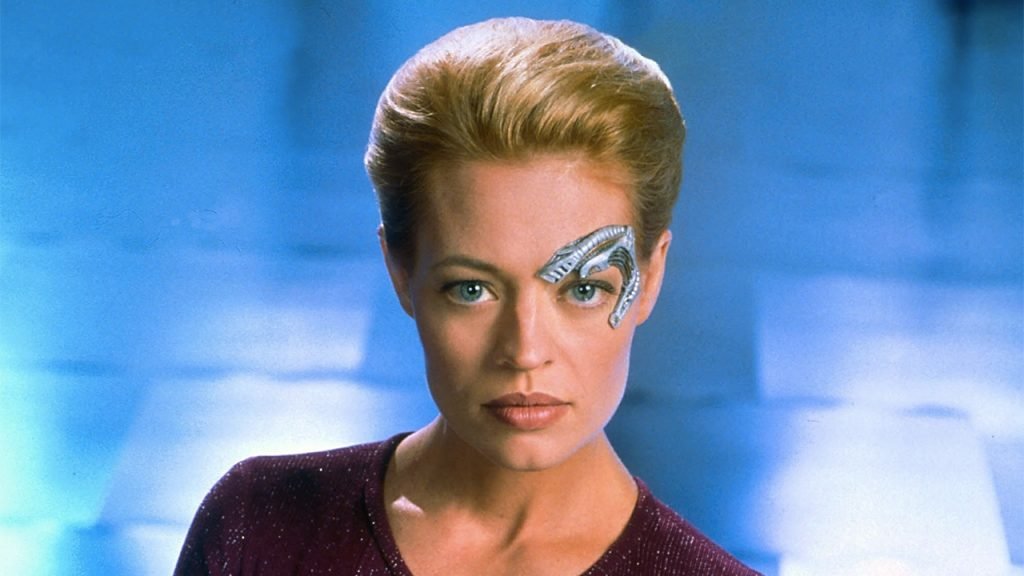
In “Scorpion Part 1”, Harry is attacked by a member of Species 8472 (now known as Undine) and was to be used as a way to let Garrett go. Ultimately it was the character of Kes that was to be let go from the Voyager cast with the production introducing a new character in the form of Jeri Ryan playing the role of 7 of 9, a former Borg drone liberated from the Collective by Janeway. Kes as a character was written off with the reasoning that her Psionic abilities were becoming too dangerous for her to stay on Voyager, due to her proximity to the Undine, which as a species, possessed similar abilities. She later returns in season 6 for a send-off episode with her power in full force. A shame, as they could have done so much more with her character. There was speculation in the media that Garrett Wang was kept due to his appeal to a certain demographic and a placement on People‘s “50 Most Beautiful People in the World” list.
Fun Fact: Jeri Ryan confessed that she had hardly seen Star Trek before and had no idea what the Borg were, and so producers sent her copies of Star Trek: First Contact and Star Trek Encyclopedia the day before she auditioned.
Similar to the characters of Spock in The Original Series, Odo from Deep Space Nine and Data in The Next Generation, the character of 7 was introduced to give a third-person perspective on the human condition and to explore it. The Doctor, while trying to develop himself, knew what humanity was and understood our traits but for 7, these were completely alien to her even though she was a human herself. 7 became a firm fan favourite during her 4 years on Voyager and became integral to the plotlines developed by the writers, going some way to help boost the show’s ratings in a period when Voyager was struggling. 7 of 9 recently returned to our screen 2020 in the CBS All Access series Star Trek: Picard.
Legacy
Star Trek: Voyager is a series that continues to enjoy a high level of popularity amongst the fan base and one that managed to break down stereotypes; introducing a strong female lead character in Kathryn Janeway.
During the 25th Anniversary, Voyager Executive Producer Brannon Braga was quoted as saying “I think most people are going to point to Captain Janeway. The best characters on the show were women. A woman was the lead and the leader. It was not something we were calling attention to; it just was what Star Trek did. it is just part of the concept that the crews were diverse […] and I think it’s one important part of the legacy of Star Trek: the depiction of diversity and equality.”
In an article about Voyager, writer Ian Grey wrote: “It was a rare heavy-hardware science fiction fantasy not built around a strong man, and more audaciously, it didn’t seem to trouble itself over how fans would receive this. On Voyager, female authority was assumed and unquestioned; women conveyed sexual power without shame and anger without guilt. Even more so than Buffy, which debuted two years later, it was the most feminist show in American TV history.” (source – Wikipedia)
Like many Star Trek shows, Voyager took a few seasons for it to find its feet and establish its own identity. It broke away from the traditional and introduced a fresh area of the galaxy to explore with new aliens and civilisations. It tried to be bold and to offer a new perspective on our favourite franchise. For the many, it succeeded with fans growing to love and care for the characters and the situations they found themselves in. Often cited for its diverse characters and boldness in its casting, the legacy of Voyager can be found in the female scientists, doctors, engineers, and captains who all point towards Kathryn Janeway as an inspiration. In the end, legacy can be an individual thing and the impact something can have on us. The Legacy of Voyager to me is that it has helped the franchise I have cherished for 20 years expand and continue to grow. To continue to escape and explore strange new worlds with wonderful characters and to continue to offer a glimpse into what our future could be if we really wanted it.
And, that Janeway was a kickass captain.
As part of our celebration of the 25th Anniversary, on what is the air date of the Voyager pilot, ‘Caretaker’ contributor Jack offers his own personal look back at an episode that was his gateway to a greater, wider universe.
Following a text crawl not too dissimilar from a certain little known George Lucas film, Captain Kathryn Janeway speaks to her future flight controller, Thomas Eugene Paris for the first time, and 8-year-old me, watching late during BBC 2’s Star Trek 30th Anniversary special, fell asleep. Half-past nine was all this boy could take in 1996 (I used to wake up at 6 am) and even though I couldn’t manage to stay awake, watching on a small portable TV in my parents old flat, Star Trek: Voyager made an impression.
The next morning, I asked my parents what I had missed (they had watched it on the proper telly downstairs that night). Voyager was flung 75,000 light-years from home; I was gripped as my mum laid out the initial plot points, but wisely stopping before giving away too much. That Saturday at a video rental shop (which is now a hairdresser) I stumbled upon a copy of Star Trek: Voyager, episode one ‘Caretaker’.
After managing to convince my Grandad to rent it for me and I absolutely devoured that tape over the weekend. It became a reoccurring theme: every weekend for just over a year, I would ‘convince’ Grandad to rent more Star Trek: Voyager tapes and with no Sky TV until late 1998, the only way to watch Voyager was through BBC 2, which could take up to a year to arrive following Voyagers initial air dates in the US and, through the future hairdressers while still in its video rental phase. Once Sky was here however, all bets were off and thanks to American mid-season breaks, those like me living in the UK would have a mere three month wait for an episode to premiere, no more year plus waiting for Jack!
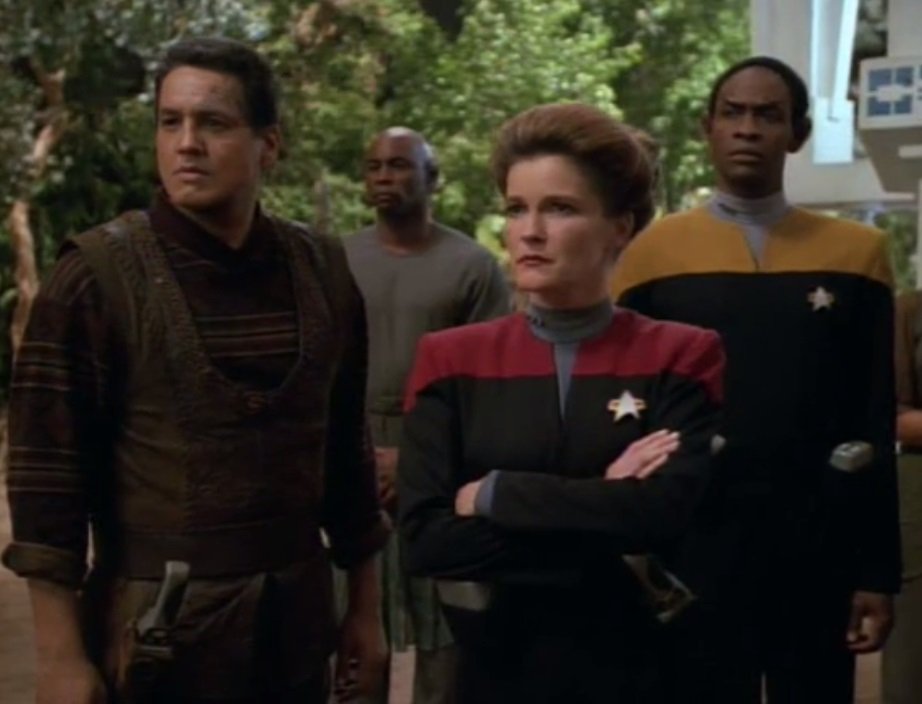
But what has this got to do specifically with ‘Caretaker?’ Well, first off it got me hooked for the full seven-year journey back to the Alpha Quadrant. When I say hooked, I mean hooked – I remember the delay to the VHS release of ‘Future’s End part II’ was particularly unbearable and in actuality, it was probably only delayed about a month. But to paraphrase my favourite Trek film – also from 1996 – ‘to a nine-year-old sir, that is an eternity.’ It’s partly why I love the franchise so much, I got the Trek symbol tattooed to my arm and every Monday I start my house cleaning by listening to Garret Wong and Robbie McNeil wax lyrical about each episode (not via their podcast, they just live in the basement).
Some of the special effects were mid 90s Computer Generated Imagery, so to modern audiences they seem a bit dated, like loading up a Sega Saturn after playing an Xbox Series X. Thankfully most of it was done by models so detailed that they look so fresh on screen that I’d forgive you for thinking ‘Caretaker’ was shot yesterday rather than in 1994.
In hindsight, there are some alterations I’d make. For one, I’d have put the original cast Star Trek: Voyager, namely Scott Jaeck as Cavit and Alicia Coppoloa’s Stadi respectively, in the opening credits so their deaths came as a surprise (the promos already told audiences the ship would be bound for the Delta Quadrant). Secondly, I would sort out some of the story elements that don’t make sense, for example why Cavit reacts to the wave by wildly lunging across the bridge and why Tuvok doesn’t just plant timed or remote explosives on the Array so the Voyager can use it to get home faster, destroying the Array so the Kazon can’t access it by triggering the bombs at the last moment. To be fair I am thankful this is not something that can be changed as it would have deprived me of 7 glorious seasons of Star Trek: Voyager.
Rick Berman and Brannon Braga get a lot of flack for 1990s Star Trek. Some is deserved. But on the accusation of cheapness, especially in ‘Caretaker’s case, I find them innocent on this charge. Between re-shooting Guinevere Bujould’s scenes, quickly redressing existing Enterprise D sets to make Voyager’s interior (during shooting on Star Trek Generations, the production team also briefly needed them) and hiring Kate Mulgrew after shooting began. ‘Caretaker’ alone cost Paramount more than the entire motion picture Star Trek IV: The Voyage Home. Perhaps these are why season one is somewhat truncated.
Overall, I can thank ‘Caretaker’ for helping immeasurably to cement my lifelong love affair with Star Trek and bearing in mind that no Star Trek series during 1987 – 2001 reaches a consistently good quality until at least season 3 (4 in Star Trek: Deep Space Nine’s case) I cannot recommend enough the need to epically binge the entire 7 seasons. You will come to love the characters, watch them grow and a rare depiction of characters morphing from total strangers to being in love, married and having their first child. If I were to give the episode ‘Caretaker’ a score, it’s an easy 5 out of 5 without question.
Jack.
Tell us your memories and thoughts on Star Trek: Voyager by joining the Trek Central community and getting involved by joining us on our social media platforms.
▶ Facebook – https://www.facebook.com/TrekCentral
▶ Twitter – https://twitter.com/TheTrekCentral
▶ Discord – https://discord.gg/f62Gbcu
